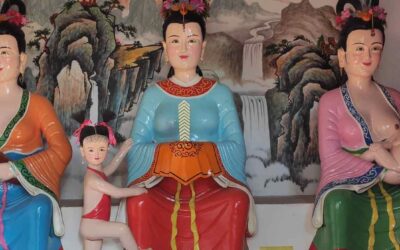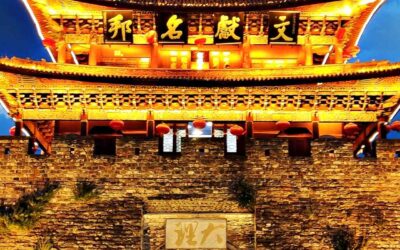An oriental interpretation of dreams
Last week, in a book about the Hani minority in the remote Jinping region, one of the authors devoted part of his article on divination to dream interpretation among the Hani. I translated it, added some comments and published it on this page. A few days later, in my research on the symbolism of bulls in China I stumbled again on the interpretation of dreams, this time those relating to cows in general.
This time I was a little more diligent, looked up a little more information on dream interpretation books, and remembered Liu Wenying’s magnificent book, An Oriental Interpretation of dreams, adding some information from it.
It is not the first time that I think of making some comment on this magnificent book, and in fact I have already quoted him in some other occasion in this web. But the task of trying to show the reader all the good things that this book contains would require an effort that I am not able to make at this moment.
Therefore, I simply copy here the index of the book, and a small and beautiful fragment about a divinatory episode of Suo Dan, in the hope of doing a little justice to the author and allowing the readers to get an idea of the value of this book.
Liu Wenying. An oriental Interpretation of Dreams. Translated by Zhang Zhixiang and Pan Chuanfa. China Social Sciences Publishing House. Beijing. 1995
CONTENTS OF THE BOOK
Preface to the English Edition
Foreword
Part One Dream Divination in Ancient China
- The Origin and Development of Dream Divination
- The Concept of Dream Soul and the Superstition of Dream Omens of Ancient Primitives
- Dream Divination Among the Yin People
- Dream Divination Among the Zhou People
- Dream Divination in the Spring and Autumn and Warring States Periods
- The Evolution of Dream Superstition After the Qin and Han Dynasties
- Theories of Dream Divination and Related Philosophy
- The Historical Traces of Dream Scholars
- Dream Diviners in Yin Buci (Oracle Inscriptions)
- Professional Officials in Charge of Dream Divination in the Western Zhou Dynasty
- Dream Diviners in “The Spring and Autumn Annals.”
- Secular Dream Scholars in Succeeding Dynasties
(1) Zhao Zhi and Song Shou
(2) Zhou Xuan
(3) Suo Dan and Wan Tui
(4) Yang Yuanshen
(5) Zhang You and Huang Fanchuo
(6) Han Quan and Yang Zijin
(7) Yang Tingshi
III. Secrets of Dream Divination
- The Historical Development of Dream Divination Methods
(1) Two Methods Used in Divining Dreams in the Yin Dynasty
(2) The Three Methods of Dream Divination Mentioned in “The Rites of Zhou”
(3) Dream Divination by Observing the Sun, the Moon and the Stars
(4) Examples: Dreams Divined by Shi Mo and Wei Ping
(5) Cross-Reference of Divinations by Dream Interpretation, Tortoise shell and Yarrow
(6) The Independent Development of a Dream Divination System
- Logical Analysis in the Dream Divination System
(1) Literal Interpretation
(2) Transferred Interpretation
(i) Symbolic Method
(ii) Association Method
(iii) Analogy Method
(iv) Decoding Method
(v) Glyphomancy Method
(vi) Homonym Method
(3) Reversed Interpretation
- Diviners’ Subterfuges and Prerequisites Before Divination
- Psychoanalysis in Dream Divination
- Circulation of Dream Divination Books
- Peculiarities and Forms of Dream Books
- Materials and Sources of Dream Books
- Circulation of Dream Books in Past Dynasties
- Existing Books of Dream Divination
- Good Dreams and Evil Dreams
- General Criteria to Distinguish Good Dreams from Evil Dreams
- Certainty and Uncertainty in Dream Divination
- Praying for Good Dreams and Supplicating to Avert Evil Dreams
- The Dream God, Dream Ghosts, Dream Incantations, Etc.
(1) The Dream God
(2) Dream Ghosts
(3) Dream Incantations
(4) Dream Grass
(5) Dream Birds
(6) Dream Insect
- Social Influence of Dream Divination
- Tokens Granted by Divine Will
- Dream Divination as a Spiritual Weapon in the Hands of Politicians
- Dream Divination as an Opiate for the Laboring People
Part Two The Exploration of Dreams in Ancient China
- The Essence and Characteristics of Dreams
- The Link Between Dream and Sleep
(1) Evolution of the Character “dream”.
(2) Implications of Shuimian in Ancient Times
(3) Mental Characteristics of Sleep
(4) Dreams Are a Mental Activity During Sleep
- Distinction Between the Dream and Consciousness.
(1) Having the Body Closed or Open
(2) Having Contact or No Contact with External Objects
(3) Depending upon Old Materials or Gaining New Knowledge
(4) Having Will of No Will, Having Mastery or No Mastery
(5) Self-Controlled When Awake and Unharnessed When Asleep: Truth Disclosed in Dreams
- From «The Spirit of Dream» to the Concepts of «Spiritual Dormancy» and «Spiritual Ambush»
- The Causes and Mechanisms of Dreams
- The Physiological and Pathological Causes and Mechanisms of Dreams
(1) The Theory of «Morbid Evil as Dream Instigator in “Internal Classic”
(2) Dream Images and Visceral Images (A)
(3) Dream Images and Visceral Images (B)
(4) Response, Seasonal and Disease Dreams
(5) Extrinsic and Intrinsic Responses in Dreams
(6) Wang Qingren’s Theory of Stagnation of Brain Qi
- Psychological and Mental Causes and Mechanisms of Dreams
(1) The Causes of «Six Kinds of Dreams’ in “The Rites of Zhou”
(2) Dreams Resulting from «Missing and Yearning»
(3) Dreams Resulting from «Frequent Emotional Changes»
(4) Dreams Resulting from «Submergence of the Mind» and «Overflow of Feelings»
(5) Dreams Resulting from «Anxiety or Delight Kept in the Heart”
- Relationship of Two Causes of Dreams
(1) The Connotations of «Thinking» and “Cause”.
(2) Transformation from “Cause” to «Thinking»
(3) Dreams Caused by Internal and External Factors.
(4) “Response of Bodily Consciousness” and «Response of Meditative Consciousness
(5) The Scientific Value of the Concept of «Overflow of the Subconscious»
- Some Specific Problems of Dreams
- Classification of Dreams
(1) The Classification of Six Kinds of Dreams in “The Rites of Zhou”
(2) The Classification of Ten Types of Dreams in «On Dream”
(3) The Classification of Four or Five Types of Dreams in Buddhist Sutras
(4) The Classification of Nine Types of Dreams in Essentials of Dream Divination
- The Time-Space Perception of Dreams
- The Diagnosis of Diseases Through Dreams
- The Accommodating Interpretation of Dreams and Mental Satisfaction
- The Relationship Between Dream Imagery and the Dreamer’s Occupation and Disposition
- The Relationship Between Dreams and Sex
- Did the Holy Taoists and Sages Never Dream?
- Do the Blind Dream?
- Are Dreams Premonitions?
Part Three The Development of Dream Theories in the Modern World
- Psychoanalysis of Dreams
- Experimental Observations of Dreams
III Creative Thinking in Dreams
- A New Dream Theory Advanced by a Chinese Scholar
- Where Does the Subconscious Come From?
- The Basic Elements of Dreams and the Characteristics of Primitive Thinking
- The Source of Dream Materials and the Image Depository in the Human Brain
- Eye Movement in Dreams and Man’s Internal Vision Mechanism
- The Mental State of the Dreamer and Its Contradictory Tendencies
- The Dream-Instigating Mechanism and the Root Cause of Dreams
- Physiological and Psychological Functions of Dreams
Author’s Postscript
Translator’s Note
Appendices
- Classified Compilation of Extant Fragments of Lost Han and Tang Dream Books as Found in Tang and Song Encyclopedias
- “The Newly Compiled Lord Zhou’s Book of Dream Interpretation” (in One Volume)
III. Materials About Creative Thinking in Dreams
Indices
- Name Index
- Title Index
III. Specific Terms
Sample Text (p. 91)
Suo Chong dreamed of two coffins falling in front of him. Suo Dan explained to him:
The coffin (棺) signifies an official post (官). A noble man in the imperial capital will recommend you. The image of two coffins hints you will be promoted twice.
There was a proverb in the Jin Dynasty :“When you are going to hold an official post, you will dream of a coffin. «Dream Book” says, “One who dreams of a coffin will obtain an official post. That is an auspicious omen.» Here, 棺 (coffin) and官 (official post) are homonyms in Chinese. As the coffins fell from above, it was inferred that a nobleman in the capital would recommend him. Before long, Wang Rong, the chief commissary, wrote a recommendation letter to the prefect of Dunhuang. As predicted, Suo Chong was promoted twice.
Once a person dreamed of a captive coming to him with his uniform removed from the upper part of the body. Suo Dan said, “If the upper half of the character虜(captive) is removed, the remaining part forms男 (male ). A captive from a minority should belong to yin. For a person, yin suggests a female. Thus, Suo Dan’s divination conclusion was.»Your wife will give birth to a boy.»
Last posts
Sexual aspects of Gu venom
Gu illness resulted from a contamination by gu poison, which a recent analyst has characterized as “an alien evil spirit which entered [the] body and developed into worms or some similar animal that gnawed away at the intestines or genitalia.” This poison was thought...
Sunset in Dali
No Words Fuxing Rd from the South Gate. Dali, Yunnan.Corner in Fuxing Rd, Dali, Yunnan.Night market at the south of the South Gate. Dali. YunnanLast posts
The five secret temples of the lamas in Lijiang
The five secret temples of the lamas in Lijiang Religions of Lijiang Although the city of Lijiang is known primarily for the Dongba religion practiced by the traditional shamans of the Naxi, also called Dongba, who with their rituals administered the religious and...







